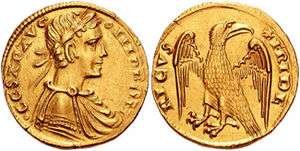Augustalis


An augustalis or augustale was a gold coin minted in the Kingdom of Sicily beginning around 1231. It was the first gold issue of Frederick II, Holy Roman Emperor and King of Sicily (1197–1250), and was minted until his death. It bore a Latin inscription and was widely circulated in Italy. It was patterned after the Roman aureus and its halves. It was minted at Brindisi and Messina with accompanying billon deniers. The style of the coinage has been described as splendid and proto-Renaissance; the quality of its execution and its fineness is high. The coin weighed about 5.24 grams, which is ¼ of a Sicilian gold ounce.
The obverse contains an classical (not medieval) bust of the emperor wearing a laureate wreath with the legend CESAR AVG IMP ROM (Caesar Augustus, Emperor of the Romans); the reverse shows an eagle, the imperial symbol, with the name FRIDE RICVS (Frederick). The name augustalis means literally "of the august one", referring to the coin's provenance from the emperor himself, but also linking it with the Roman Emperor, who was commonly styled Augustus.
References
- "Augustale." (2008). In Encyclopædia Britannica. Retrieved 7 October 2008.
 This article incorporates text from a publication now in the public domain: Chambers, Ephraim, ed. (1728). "article name needed". Cyclopædia, or an Universal Dictionary of Arts and Sciences (first ed.). James and John Knapton, et al.
This article incorporates text from a publication now in the public domain: Chambers, Ephraim, ed. (1728). "article name needed". Cyclopædia, or an Universal Dictionary of Arts and Sciences (first ed.). James and John Knapton, et al.